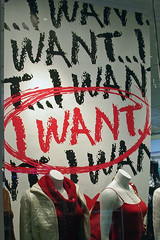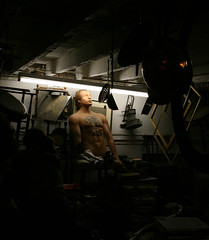The World Clock Project says:
We find it intriguing to see a picture of a clock that is located thousands of miles away, but one which tells us the exact time of where we are right now. So we’ve set out to collect as many pictures of clocks as possible from as many different people as possible from around the world. Our goal is to gather enough pictures to account for all the minutes of the day. Upon accomplishing that, we will create a “digital picture clock” for the community.
Check it out here. You can email your own clock pix or use the related Flickr group.
Posted Under:
Pleasing
This post was written by Rob Walker on October 31, 2007
Comments Off on Building a digital picture clock, with your help
I’ve long contended that most of the stuff we read about how people are so “confessional” online is a bunch of hooey. MySpace and its ilk aren’t about confessing. They’re about presenting a marketed version of yourself — better looking, smarter, cooler, etc.
And what better summation of this could there be than the fact that everybody’s “friend” Tom has evidently been lying about his age. He wasn’t 27 when co-founded MySpace, he was 32. Soon he’ll be 37, a veritable geezer! Thumbs up, Tom.
Chris “Long Tail Guy” Anderson lashes out at lazy PR people in this post, going so far as to list the email addresses of those he’s blacklisted. The comments to the post are interesting: Some criticize Anderson for leaving the addresses out there for spam bots to harvest. And one guy explains how he spends thousands of dollars to by email lists to promote his photography business. (As the replies note, that money may not be well spent if the lists include people like Anderson, who as editor in chief of Wired is not a relevant contact.)
I’m sympathetic to Anderson’s point of view, in that I get a ridiculous amount of PR email from people who clearly have no idea what I write about. In fact I recognize several of the addresses on his blacklist. I try pretty hard to be accessible because I like hearing from readers, and actually I like hearing from anybody who has a good, relevant idea for me. And I’m not slagging everyone in PR here — I do have regular contact with some very clever people in that line of work, who actually understand what I’m interested in.
The trouble is figuring out a way to be accessible without being overwhelmed by static. I used to publish an email address in the Times Mag for Consumed, but I had to have them take it out, because basically the address was getting added to so many PR blast lists it became useless, drowning out the feedback from real readers in a sea of off-point flackery. Pretty sad.
So I don’t know if Anderson’s post is the best solution to the problem, but I do think it’s a problem.
Posted Under:
Flickr Artifacts
This post was written by Rob Walker on October 29, 2007
Comments Off on Flickr Interlude
Blog Neuromarketing mulls the way the brain processes specific numbers and percentages differently, keying off the discussion of “framing” in Jason (not Philip) Zweig’s book Your Money and Your Brain. Zweig’s point is to help regular people understand how the different ways we think about absolute numbers and percentages can lead us astray. Neuromarketing approaches the subject from a, uh, different angle.
There are times when marketing and public relations people do have to address negative topics, as when dealing with press coverage of a company problem. In these cases, I’d recommend percentages. “Only 1% of our laptop power supplies have actually caught on fire” is, from a framing standpoint, better than, “Only 1 out of 100 …” Bad news is bad news, but people will be less likely to visualize their legs getting scorched if they don’t imagine themselves as “the one.”
Great!
Posted Under:
Consumer Behavior,
Ethics,
Murketing
This post was written by Rob Walker on October 29, 2007
Comments Off on How to soften the truth about your company’s defective products
Here — maybe — is another example of the counterfunctional value discussed in yesterday’s Consumed. It’s a bookshelf that rocks back and forth. Core77 says:
Julian Appelius‘ Topple bookshelf leans ever so slightly on its rocking base–5° to be exact–when books are stacked on, creating the perfect amount of tilt to add some extra stability. A bit ironic, yes, but it works!
One might fairly wonder what the upside of this approach is, over, say, a perfectly stable bookshelf. To echo Jonah Berger’s point in the column, regarding watches that do a less-than-optimal job of telling you what time it is, this seems like another object whose main value is that it “provides more information” about the owner. And part of that value is that not many others will swarm in to buy the thing and water down its identity value, because most people will want a shelf that doesn’t move.
Speaking of that line about counterfunctional watches “providing information” about those who wear them, Marginal Utility has this amusing reaction: “Exactly, it screams loud and clear that you are an idiot.”
From the L.A. Times writeup on the Murakami show at MOCA:
Murakami has spoken about the kudzu-like proliferation of ultra-cute imagery in Japanese culture — Hello Kitty, say — as a colossal index of repressed confidence in the wake of a militaristic nation’s humiliating battlefield defeat 62 years ago. Even death now seems infantilized, as in his remarkable paintings of a skeleton whose mushroom-cloud shape is horribly adorable.
The conceptual debt to Andy Warhol, here and everywhere in the show, is obvious. But the squeamishness induced by Murakami’s distinctive brand of Pop Art is entirely different.
And I emphasize brand. Murakami is the first major artist, Eastern or Western, to make our pervasive culture of branding a primary subject, rather than simply exploiting it.
Worth a read. I would love to see this show, but I doubt it’s in the cards. At least Bobby Hundreds has posted a bunch of images here.
Bonus Update: Eric Nakamura (Giant Robot) blogs about the gala and the goodie-merch.
Posted Under:
Artists,
Cuteness,
Meta-Brand News
This post was written by Rob Walker on October 29, 2007
Comments Off on Murakami’s subject: “Our pervasive culture of branding”
 Low-functionality watches: How the value of a watch becomes detached from its role as a timekeeper.
Low-functionality watches: How the value of a watch becomes detached from its role as a timekeeper.
The chief function of a watch, you might assume, is to tell the time, accurately. But watches can do other things too. Some years ago, for instance, there was a trend toward watches with calculators built into them, although that didn’t last. Also there’s the aesthetic factor. The look of a watch might sound more like a matter of form, but style has its functions, too.
The watch is an interesting product category through which to examine the function of style…
Continue reading at the NYT Magazine site.
Regular Murketing readers will recognize that this is theme I’ve pursued a bit here, in previous posts here, here, here, here, here, and here.
Posted Under:
Consumed,
The Designed Life
This post was written by Rob Walker on October 28, 2007
Comments Off on In Consumed: Timeless Objects
The caption: “Rampant Consumerism is the product featured in this window display from the store Wet Seal, at the Santa Rosa Plaza. In case you don’t have the proper mindset for mall shopping, Wet Seal has a helpful hint.”
Posted Under:
Flickr Artifacts
This post was written by Rob Walker on October 28, 2007
Comments Off on Flickr Interlude
See also the enjoyable set Trash.
The other day I got an email informing me about this web site: Catalog Choice. It is a “sponsored project” of The Ecology Center.
The idea is that you can use the site to opt off the mailing lists of various catalog-sending retailers.
I’ve finally gotten around to registering (I don’t exactly know why that’s necessary, but maybe there’s a good reason) and have started entering catalog info. You kind of need each unwanted catalog at hand when you’re doing this, because part of the process is entering the customer number from the label. They say it takes 10 weeks or so for each catalog to stop. And they don’t have every catalog in the system yet, but you can make requests.
So anyway I’ll let you know what happens, but if anybody else out there is interested in stopping the rather wasteful flow of paper … now you know.
Yes, as a matter of fact, the Wall Street Journal’s front-page story today on Nike “tapping influencers” is several years late. But it’s still worth reading. (And at least they got it. While I’ve mentioned things like Futura and Mr. Cartoon, to name two examples in the piece, doing Nike stuff in the past, my own attempts to get an interview with Mark Parker a couple of years ago were totally stonewalled. Oh well.) In particular I liked this bit:
Not everyone is so anxious to see Nike roll into new turf. Recently, designer Steve “Birdo” Guisinger, owner of a small but influential Santa Cruz, Calif., retailer called Consolidated Skateboards, painted three wheel-less skateboard “decks” with images that lampooned Nike’s attempts to craft a more street-smart image. The board depicting Mr. Parker shows him in a T-shirt with flame tattoos running up one arm and a chauffeured white limousine waiting behind him.
Mr. Guisinger says the parody was meant to “raise awareness,” about the “behind the scenes jockeying that was going on with [Nike’s] attempt to enter the skateboard industry.”
Nike’s response was characteristically in-your-face. Global design head Sandy Bodecker — shown on one of the boards with a sales projection chart and a brown nose — purchased them on eBay and recently displayed them proudly in a prototype for a Nike retail concept store. “I personally was very pleased to be in such august company” he says.
Heh.
There’s also some material about Os Gêmeos. I was sort of pitched about Os Gêmeos at one point, but my interest was entirely in the role that Nike played in basically establishing them in the U.S. scene, and I was told that nobody involved was really interested in talking to me about that angle. But you get a decent sense of it here — Parker introduced them to the Deitch gallery, etc. So, again, the broad theme of the piece isn’t going to surprise anyone who’s been paying attention, but they got some facts.
Seriously, how can something be both so popular, and so consistently, relentlessly, hideous, at the same time?
I’ve read a million stories and experts talking about how more of us know more about good design than ever and we crave it and we’ll pay for it etc. But face it: MySpace remains more popular than almost any good design product you can name, and it’s uglier than the 1970s.
So has the country’s collective design taste improved — or not?
UPDATE (December 8): In addition to the comments below, which are now closed, see this follow-up post and comments.
Business Week had a story recently about Kenneth Cole’s brother, Neil, who is now running a company called Iconix. The business model of Iconix is that it buys fashion brands — but just the brand, not the company. Through a licensing arrangement, it sells others the right to actually design and manufacture the apparel, in exchange for a “guaranteed royalty of 4% to 10%.” (I’m assuming that’s a percent of gross, not net, but if the article says for certain, I missed it.)
I was interested to see that its most recent deal is with Wal-Mart, which will be “the exclusive U.S. licensee of the surfwear pioneer Op brand.” I used to wear Op when I was in junior high or so, and about two years ago I think I noticed that a boutique I like in Manhattan, Gerry’s (which tends to stock brands like Ted Baker and Modern Amusement), was carrying Op stuff, which I hadn’t seen in many years. I remember chatting with clerk about it, and he claimed it was selling well. Since then I’ve seen some Op ads in some hipster lifestyle magazines, and even briefly considered doing a Consumed on it, but never did.
Other Iconix brands include Joe Boxer and Mossimo (which I gather are exclusively sold in Sears/K Mart and Target, respectively), and, I was surprised to learn, Roca Wear.
The article spends more time on Cole’s up and down career than on details of this business, but supposedly it’s doing well. (Although some of the downs in his career kind of give me pause.)
What’s interesting about licensing businesses in general is that despite the assorted chatter about brand-skeptical consumers, licensing can be very lucrative precisely because of brands’ power to transform commodities. It’s particularly interesting when it happens with brands that have fallen on hard times, but are still familiar. With the right cost structure and the right marketing, they can build on that familiarity. (This is the subject of an article I’m working on now, actually, so more on that in the future.)
Op will be an interesting one to watch, and I wish I knew more of the back story. Was it totally dead for a while? Who was behind the Op stuff that was popping up in Gerry’s, of all places? From whom did Iconix acquire the marks, and when? Who will be doing the designs? Lots of people will recognize the brand when they see it, but younger people probably won’t. Who will the consumer be? Etc. Like I said, should be an interesting one to watch.
UPDATE: An incoming link leads me back to this bit on an interesting blog called Legal Fixation: “Although there are numerous OP and OCEAN PACIFIC trademark registrations, the assignment history of this OCEAN PACIFIC registration gives some good clues as to the transactions.”
Posted Under:
Flickr Artifacts
This post was written by Rob Walker on October 23, 2007
Comments Off on Flickr Interlude




 "
"


 Low-functionality watches: How the value of a watch becomes detached from its role as a timekeeper.
Low-functionality watches: How the value of a watch becomes detached from its role as a timekeeper.














 Kim Fellner's book
Kim Fellner's book  A
A